Table of Contents
Round The World Guide

Going on a round-the-world trip is for many people a dream come true.
A few years back, I went to travel around the world during 18 months without any programmed destinations. I had no pre-arranged itinerary.
Through my personal experience, I will share with you practical information about all you need to know to go on a Round The World Trip (RTW).
Round-the-World back in history

The desire to explore, to go further, to get to know new lands is almost as old as humankind. In the beginning, one had to survive, to make sure there was enough food, and ensure the safety of each individual as well the group. But as soon as it became possible, human beings went out to conquer the world.
In those days, the curiosity of discovering new land had a more practical reason: to establish commercial routes and strategic alliances with powerful faraway kingdoms.
That’s how Marco Polo left his home city of Venice only to return 24 years later, leaving behind the trail of a journey of over 22,000 km through Asia. But before him, in the 14th century, Ibn Battuta had covered an impressive 120,000 km of land that now corresponds to 44 countries.
Since the beginning of the 15th century, Portuguese sailors braved the unchartered oceans looking to establish a lucrative sea route to India. With that goal in mind, they ended up discovering islands lost in the immense Atlantic Ocean and established commercial posts in all the sub-Saharan African coast. After India, the South of the Atlantic and Brazil in South America followed. The Empire grew and strengthened.
But those were different times. At a time when brave sailors left behind the safety of Lisbon, venturing through the merciless waters of the Atlantic, believing they were traveling towards the end of the world. In those days people firmly believed the Earth was flat and finite, ending somewhere abruptly. For every day they spent at sea, they hoped to reach the end of the Earth and to be swallowed by the unknown.
For everyday man, the thought of a spherical planet was completely odd. But some, like Christopher Columbus, knew about the old Greek theories that talked about a sphere-shaped Earth.
And that’s how Columbus possibly became the first candidate to a round-the-world trip. The project he presented to the Spanish king was based on that idea: to reach India from Europe, in the opposite direction, circling the globe and reaching India from the other side.
Fate didn’t allow for Columbus to conclude his expedition and he only reached America thinking he had reached the so-called Eastern Indias.
The Expedition of Ferdinand Magellan
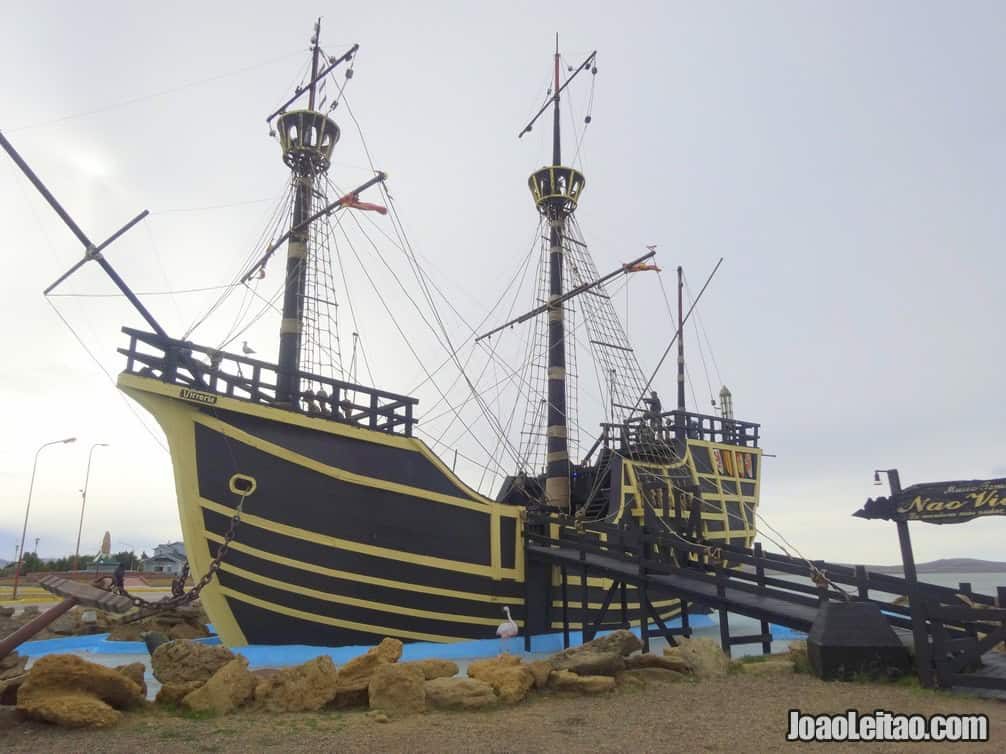
However, that original idea was not completed dismissed. Spain sponsored at least two more expeditions that tried to reach further, unsuccessfully. Not too long after, an experienced Portuguese sailor called Ferdinand Magellan (Fernão de Magalhães) was hired by the Spanish king to complete Columbus’ dream.
Ferdinand Magellan’s fleet departed Seville in 1519 and, managing to dodge the Portuguese Navy’s surveillance, sailed South, restocking in the Canary Islands. After one more stop, in Cape Verde this time, they sailed towards the Brazilian shore without reaching too close, to avoid the threatening Portuguese established there.
After restocking once more, Ferdinand Magellan went South looking for the passage that he believed opened the way to India. In October of 1520, his ships went around the most southern cape in South America, starting to sail Northeast towards Asia.
After passing by the Mariana and Guam islands, they reached the Philippines where Ferdinand Magellan would die after fighting with local tribes.
The man died but the project lived on. Severely reduced by disease and fights, the crew couldn’t maintain the three remaining ships. They set the Concepción on fire and focused on keeping the Trinidad and the Victoria.
Later, the Trinidad began to leak. The Victoria wasn’t big enough to accommodate all men and they separated. The bigger ship tried to return following the same route that brought them there, but they were captured by the Portuguese and the ship sank during a storm.
Under the command of Juan Sebastián Elcano, the Victoria tried to return to Spain sailing West. It reached on 6 September 1522 with 18 survivors aboard. The first round-the-world trip in history was complete.
How to plan a round-the-world trip

1. When to Go
Most travelers want to go somewhere when the weather is nice. Well, this is simple when you’re picking only one destination. Just look for information on the best time to visit, consider a few factors, and book your tickets.
Well, things get trickier when the world is your destination. Although most trips around the world happened in smaller latitudes, don’t think the weather stays the same as you travel further around the Earth.
In addition to the weather, that we hope to be dry and warm, there are other factors the traveler keeps in mind: price fluctuation, political events that might affect the stability of individual countries, and dates of festive events.
Prices may vary significantly and affect the global budget, especially if you’re planning a round-the-world trip as an independent traveler and with lots of overland traveling. In most places, the variation isn’t too big, but it’s best to prepare for increased prices in accommodation, restaurants, and long-distance transportation during the high tourism season and special events.
Moreover, account for the possibility of having a hard time finding accommodation if you reach a place at the time of important events. It’s better to research and plan and avoid any dates with a more significant number of visitors. Unless, of course, you’re particularly interested in that event.
2. Weather
Some scenarios are explicit: traveling in the Middle East or the North of Africa in the peak of summer is like moving through hell. The heat will be unbearable, and you’ll spend most of the days where there is air conditioning.
You don’t have to be a genius to know that going further up north during the winter will impact your trip, when there’s no sunlight but plenty of cold and snow storms.
But the world is full of climate phenomena, and it’s impossible to know them all. How to plan a round-the-world trip means a lot of research. Never stop searching for the right information. The quality of data you gather could mean the difference between a sweet memory or hell.
Let’s imagine that you want to include India in your route. You can’t wait to see Taj Mahal or explore the fascinating Varanasi. But do you know that the Monsoon starts in June and that a significant portion of the country turns into a sea of mud because of the non-stopping pouring rain? The same thing happens in Southeast Asia between May and September.
However, consider the possibility of being bold. Choosing the most adverse seasons could come with unexpected advantages. Tourist sites are almost empty, and prices drop. And some places become more beautiful. For example, few people choose to visit Angkor Wat in Cambodia during the rainy season. But that’s precisely the time of year when the plants around the temples look more beautiful. They’ll completely dry out during the dry season. Some phenomena only happen when it’s supposedly the worst time to travel, like the Northern Lights that are only visible during the coldest months in the places closer to the arctic circle.
- To gather information on the times with the best and the worst weather in each country, visit the websites Best Time to Go and The Best Time to Visit.
NOTE: I personally like to travel during the Summer, since it is usually low season. Apart from zero tourists, prices tend to be cheaper.
4. Healthcare
Some trips around the world, especially those made by plane, won’t pose too many risks to traveler’s health, because they’ll be in controlled environments most of the time.
Other more “extreme” options could take you to areas where diseases like malaria, dengue or yellow fever are common, and you’ll have to take as many precautions as possible.
To know what’s the best strategy for such health threats, book a specific appointment for travelers at your local National Health System office, or directly with something similar to the National Travel Medicine Office.
If you want to research for yourself before scheduling an appointment, there’s no better website than the CDC – Centers for Disease Control and Prevention.
5. Insurance
Some people will think it’s best to buy travel insurance that covers every possible incident and accident. Others will be fine with a simpler insurance policy with basic coverage that assures medical assistance in case of emergency and eventually traveling back to their home country. The bold adventurers will simply go travel without worrying about such things.
Always remember:
- You don’t have to invest in expensive RTW travel insurance with full coverage, but even the most adventurous of travelers should know that mishaps happen;
- Something so trivial like breaking a foot, for example, can cost you a fortune if you’re caught off guard and have to pay for treatment yourself.
a. National Health Insurances
These are the insurances you can get from insurance companies based in our country. They’re more affordable, any insurance agent can handle them, and you get personalized assistance. On the other hand, the coverage they offer is not as detailed as the ones provided by specialized companies. If you want some protection but aren’t paranoid about insurances, this could be a good solution.
b. Specialized Health Insurances
There are several specialized insurance companies based abroad that work mostly online, and offer different kinds of travel insurance policies. Those are highly specialized companies, reputable and used by many people all over the world. They’ll be more expensive than the national health insurances, but they’re a lot more detailed and completely developed for travelers. World Nomads is the world leading company of travel insurance.
- Read my page: How to get travel insurance.
6. Passport and Visas
You will obviously need a passport and possibly some visas. Considering this is a big trip, please take note of your passport’s validity date. Keep in mind that many countries don’t let tourists in if their passport’s validity date isn’t more than six months after arrival.
When it comes to visas, you’ll have to deep dive into the conditions of each country where you’ll be traveling to. Especially if you’re planning your whole trip before leaving.
Here are some problems to anticipate and get ready for:
- countries that demand a return ticket;
- requiring proof of financial resources that attest that the traveler will be able to support himself while staying;
- countries that demand the visa is requested at the embassy on the traveler’s country of origin or the closest embassy.
This might not seem like an issue, but visas have a validity date therefore if you’re traveling to one of these countries at the final leg of your trip, you better pay attention to the dates.
For the first approach to visa issues, research Wikipedia. Google search something like “Visa Policy of [name of the country you’re visiting].”
- Read the Wikipedia page: Visa policy of Uzbekistan.
7. Quick Tips For A Trip Around The World
Make copies of your documents
Always carry copies of your documents such as passport, drivers license, international health card, personal ID, etc.
Do You Need a Visa?
Know which countries you’ll need a visa to visit so you can take care of that in advance.
Make sure your vaccines are up to date
There are some vaccines you need to make sure are up to date before traveling: yellow fever, cholera, diphtheria, Japanese encephalitis, hepatitis A, hepatitis B, flu, rabies, tetanus, and typhoid fever.
Make sure your passport is valid for several months
If you’re traveling for a year or more, it’s not a good idea to carry a passport that will expire in 5 months.
Make sure you have enough blank pages on your passports
If you’re traveling to many countries and your passport doesn’t have enough blank pages for stamps and visas, get a new passport.
Consider if you need travel insurance
We never think something wrong will happen to us, but travel insurance doesn’t cover only the horrible and drastic situations. There are other incidents covered by travel insurance: canceled flights, lost luggage, stolen gear, medical appointments, and other minor medical assistance, etc.
Always carry US dollars or Euros
Don’t take for granted that you’ll always be able to withdraw cash from an ATM. Some destinations don’t have ATMs, or the ones that exist are out of order or don’t have cash. It’s always a good idea to have a backup stash in US dollars and euros.
Carry a mini first aid kit
It’s always a good idea to carry a mini first aid kit with bandages, band-aids, some pills for diarrhea, betadine, etc. Don’t go overboard and pack a small kit with the essentials.
Forward your mail
Find someone who can check your mail regularly to see if you’ve received something important from the bank, from work, etc.
Notify your bank about using your credit cards abroad
It’s crucial that you let your bank know that you’re traveling. I’ve found myself abroad with all my cards blocked because my bank suspected someone was committing fraud with my credit card.
Buy a mini laptop
Traveling with a light backpack is very important. Some laptop brands are great to travel, they’re light, fast, and have good storage capacity.
Buy a good quality camera
When you’re on a unique trip, it’s important to keep a record of the best places and the best moments with a good camera. I, personally, like and prefer to travel with a compact camera.
- Read my page: Best Travel Photography Gear.
Around the World by Airplane
Buy a round the world airplane ticket
This is a good solution for those who spend a little more money but save the time it would take you to plan your route. Using this method, the traveler will buy only one ticket for a round-the-world trip, using the partnerships between airlines to travel around the world.
Please note that it doesn’t matter how many airlines you’ll use: you’ll be the customer of the airline operating your first flight and that’s the one that will take care of you throughout the whole trip. I suggest you choose a reputable airline for that first flight, considering the quality of service, customer care, and general conditions.
There is some flexibility but with some limitations: it’s true you can change the dates of the pre-booked flights without paying additional fees, as long as there are available flights, but you can’t change the point of departure or the point of arrival of each pre-defined flights, at least for free.
At the moment, three airline associations are offering this type of Round the World ticket:
- Star Alliance (probably the best known and the one with more offers when it comes to destinations and airlines);
- One World;
- and Sky Team.
If you choose this option for your round the world ticket, consider some additional points:
- You have to fly in one direction without turning back, meaning from East to West or the other way around. The Atlantic and Pacific Oceans work as virtual gates. Once you’ve crossed them, you can’t fly over them again in the opposite direction. However, in the same continent, you can make slight adjustments to the route, according to the “territorial zones” defined by the airlines’ alliance.
- The country of departure must be the same country of arrival, and the trip can last from 10 days to one year. The good news is if you collect point miles, all this traveling will increase your allowance, even including the overland portions of the trip.
- Don’t let yourself feel intimidated with the need to having a plan before leaving. If besides wanting to travel around the world, you want to take time to explore some regions that appeal to your senses and imagination, you can always stay for a few more weeks or months on that part of the world, traveling at your own pace, and maybe using low-cost local airlines.
How to buy a RTW Air Ticket
1. Star Alliance
With Star Alliance, your ticket fee is based on the length of the trip. In your destination map, there are over 1,300 airports, with flights to practically every country in the world.
As for baggage allowance, Economy and Economy Premium passengers can check-in one piece of 20 kg luggage, the Executive passengers can check in two bags up to 30 Kg, and First Class passengers can go as far as 40 Kg. Star Alliance is very clear about its conditions from the start: you can only cross over the Pacific and the Atlantic once; you must include 3 to 15 stops; you can add up to five overland routes, but the first trip between continents has to be made by plane.
Their simulator for buying a round-the-world trip ticket is efficient and user-friendly, but it’s not perfect. Design a route that departs from Lisbon, and stops in New York, San Francisco, Honolulu, Singapore, Goa, Dubai, Amman, and returns to Lisbon. The website shows an estimate of 3,734 Euros.
But when defining the dates and choosing flights, there were some issues. After selecting the details for most routes, it was clear that Star Alliance doesn’t have a member operating flights between Dubai and Amman. What’s the solution? Go to Europe, with two layovers, and return to Asia.
The problem should be easily solved by adding an overland route or choosing alternative airports. But that meant you had to go back a few steps in the simulator.
2. One World
One World calculates tariffs based on the plan the client chooses: One World Explorer, based on the number of continents visited or flown over, while Globe Explorer, like Start Alliance, focuses on the number of miles traveled. That means if you’re interested in going on a long trip, with over 39,000 miles, it could be better to use One World Explorer that doesn’t take into account the distance. Children until 11 years old get a 25% discount.
Currently, it flies to over 1,000 destinations in 150 countries and has 15 partner airlines.
Unfortunately, its simulator is not user-friendly. The choices of flights are limited and mean countless changes to the original travel plan. For example, the website shows you a connection Goa – Lisbon but it needs an initial flight to Qatar and a second flight to Boston from there, and only then you can board a flight to Lisbon. It’s a 34-hour flight for a trip that could be done in 7 hours.
The interface is so confusing that you’ll probably won’t make it to the end of the planning stages where you see the prices.
3. Sky Team
This alliance of 21 airlines covers 1,064 destinations in 168 countries. Baggage allowance is of one check-in bag up to 23 Kg for economy class or two bags up to 23 kg for executive class. Children up to 11 years old get a 25% discount.
The Sky Team simulator is not the best and looks Google translated, with parts of the website mixed in different languages or poorly translated parts. Fortunately, the rest of the process is seamless, and we get an estimate for a similar route on Star Alliance (without the layover in Amman): 3,578 Euros. However, once you lay down all the details, choose the dates and the flights, the final price for our round the world trip with Sky Team is 4,315 Eur.
Why is the estimate different from the final price?
When you insert your ideal travel plan into the simulator of one of these airline alliances, they calculate the total of miles between cities and frame it into one of their tariffs.
Let’s picture that our route is 38,000 miles long and that you’re using the Star Alliance simulator. This alliance has three tariff tiers: up to 29,000 miles, up to 34,000 miles, and more than 39,000 miles. The website will estimate that your trip fits the middle tier.
But here’s a question: what if some of the courses you choose isn’t operated by one of the member airlines of the Star Alliance? To work around this, you’ll have to take one or more layovers and add miles. Therefore, you’ll move up to the next tier, and you can’t see that until you choose the dates and the flights.
4. Multi-Stop Ticket Agencies
In addition to the alliances, that gather many airlines, there are online companies that group tickets, in a sequence, from point A to point B, and sell it as a package.
The most significant advantage of these agencies is that the routes won’t be limited to the ones operated by the airlines of an alliance. Any flight can be included in the package, and you can avoid unnecessary miles and connections, by choosing the fastest and most direct flights.
Other strengths of these agencies
That idea of splitting the trip in smaller chunks is essential because you can’t make changes to the dates of the flights through these agencies without paying a fee. Actually, a double charge, because you’ll have to pay to the airline and the agency.
Another plus side of this option is their quality of service and customer care. They not only sell you the tickets, but they’ll provide travel consultancy, with experts who are available to help customers plan their trips.
With multi-stop tickets, the traveler only pays for the trips he takes. That means you can opt to travel overland for a big portion of your trip. Explore the area, take a closer look at the world. Use public transportation. If you choose buses, trains, or boats, you’re not paying for the air miles of the same route.
Generally speaking, and because you avoid layovers and indirect flights, a round-the-world trip using this system can be cheaper than one with the alliance tickets.
5. Bootsnall
Indie Bootsnall has a smooth and user-friendly simulator that allows you to build customized round-the-world trips. One of the good things about the simulator is that you can choose flexible dates. When you turn on this option, the system will find you the best connections, without bothering the user with the task to select all the dates.
Let’s use the same test route we used before: Lisbon – New York – San Francisco – Honolulu – Singapore – Goa – Dubai – Lisbon. Compared with the alliances, the price is nicer at around 2,000 Eur. Almost half the cost of the other option.
6. AirTreks
AirTreks company uses the same simulation software as Bootsnall but with fewer options. On AirTreks you can only see an estimate of the cost, without dates, and it redirects the user to get in touch with the company so an expert can assist you with the final product.
7. Agencies with Pre-Defined Solutions
Aware of the demand for trips around the world with pre-defined packages, some agencies prepare standard routes that travelers can purchase for a fixed price. It’s the best solution if you want to check a round-the-world trip off your bucket list without spending too much time and energy planning it. Of course, there’s close to zero flexibility, but the prices can be very affordable.
STA Travel has ten available routes, although only seven of them are genuinely round the world trips. The most affordable ones are around 1,200 Eur, and they’re meant for those who want to feel like they’ve been around the world. There aren’t many stops, but it is, in fact, a trip around the world: London – Dubai – Auckland – Los Angeles – London.
Want something big, but that doesn’t cost a small fortune? Give this route a look: London – Toronto – Buenos Aires – [overland trip or flight paid by the customer] – Bogota – Fort Lauderdale – Los Angeles – [overland trip or flight paid by the customer] – Las Vegas – Vancouver – Tokyo – Manila-Hong Kong – Bangkok – Dubai – London for 2,000 Eur.
8. Promotional Packages
If you’d like to travel around the world, but your budget doesn’t have room to bring this dream to life, cheer up because there’s one more option.
From time to time that are unbelievable promotions, sometimes because someone made a mistake when typing the price and other times because there’s really a promotion. Once you find a deal, there’s no flinching. Book before they run out or before the airlines cancel the offer.
- What if I told you if not too long ago you could have booked a ticket for a Madrid – Seoul – Beijing – Los Angeles – Madrid trip for… 650 Eur?
- Another example showed up on the same websites: Madrid – Oslo – Los Angeles – Bangkok – Dubai – Madrid. For how much? 790 Eur.
Of course, these situations aren’t strung on personal preferences. When you find them, take them or leave them, accept the routes and the dates in the blink of an eye. And that, unfortunately, isn’t for everyone.
Around the World without Flying
Some people say that taking flights is not actual travel. It’s cheating; it’s escaping all the adventures and difficulties that you won’t find when flying. It’s covering ground in a couple of hours when you could take weeks or months doing it overland. It’s no wonder that traveling around the world without flying is highly praised.
To many, a real trip around the world has to be made overland. All of it. Facing challenges as they come along. But of course, an adventure this great is not for everyone. You need to be physically fit and have a very particular personality. Besides, you’ll need more time and a bigger budget. But still, don’t assume that an everyday citizen can’t embark on such an adventure.
Crossing continents is no longer a problem. In the modern world, there are connections by train, or bus, or smaller public transportation. But apart from certain areas, like the Sahara desert, and regions under armed conflicts where it is too dangerous to travel, crossing continents is not a problem for experienced travelers.
The big Atlantic and Pacific Oceans are the main problems. In the good old days, at the time Jules Verne wrote “Around the World in 80 Days”, things were ironically simpler. The technology wasn’t much help for travelers, but steamships were. And that made all the difference.
Have you thought how to cross the oceans if not on a plane? By boat of course. But how? The truth is that in the past there were many routes and many ships crossing the seas, but as the airlines became more popular and affordable, those sea routes practically disappeared.
Let’s be real, who would rather board a ship to cross the Pacific for weeks when they can cover the same distance on a plane in just a few hours? Maybe if they’re afraid of flying but the modern world shows no mercy. There aren’t long-distance passenger ships anymore.
Of course, there are cruise ships, but those cater to tourist routes, not to just travel from point A to point B.
Is this a problem without a solution? No. Although it’s practically unknown to most people, you can cross the ocean aboard a cargo ship. It’s expensive, but it’s unique. And it’s one way to solve the problem.
Around the World by Train

All-Included Package
Great Rail Journeys, a British company specialized in long-distance train travel, announced in 2014 its most ambitious travel product: a round-the-world trip in 51 days.
The route spreads through 34,000 Km, departing and arriving in London. The first leg crosses the Atlantic Ocean, taking the traveler to New York. From then on, train enthusiasts have every reason to be excited.

After two days in the Big Apple, the North American coast-to-coast trip begins, allowing travelers to immerse themselves into the deep history of railways. This trip lasts for 20 days, with the first leg connecting New York to Washington DC.
Next is Chicago and Denver, and it’s in that last city that the most historic sections of the trip happen, putting the passenger in touch with some iconic trains of the American West:
- first, the Royal Gorge Railroad, with restored 1950s cars;
- then the Denver & Rio Grande Railroad route, one of the most scenic train trips in North America, across the Rocky Mountains;
- later the Durango & Silverton Railroad, a classic train on a narrow-gauge railroad with a real steam locomotive.
The crossing of the USA is close to an end, but there are two more exciting moments before resting in San Francisco: the first one, is the Grand Canyon Railway route and the second one is the Coast Starlight train, that follows the winding west coastline to San Francisco.
You’ll then cross the Pacific Ocean on a long-haul flight to Shanghai, where the second leg of this adventure begins, traveling across Asia. From China you’ll go to Mongolia, visiting historical sites like the Terracotta Warriors and the city of Beijing.

The train trip continues towards Russia, stopping in Ulan, Baikal Lake, Irkutsk, Novosibirsk, Yekaterinburg (where the last dynasty of the Russian czars, the Romanov family, was executed after the 1917 Revolution), and Kazan. The Russian-Asian part of the trip ends in Moscow.
In this part of the tour, they include a flight to Venice, an unusual option for a train trip around the world. The final part of the journey starts in that Italian city, with a quick train trip across Europe towards London where you’ll finish the almost two-month-long adventure.
The main advantage of this Great Rail Journeys package is that it’s organized for you. All you have to do is pay and enjoy the ride. It’s a high-quality package, with activities and tours in the main cities you visit, and luxury accommodation in famous hotels.
But the price of almost 30,000 Euros for this trip is not for everyone, and the unnecessary use of alternative transportation may be a nuisance for the train enthusiasts. The departure time is another disadvantage. There are no options regarding this: there’s only one trip per year.
Plan it Yourself

For some, planning a trip is as exciting as the trip. Spreading out maps and notebooks, and gathering all the information until the pieces of the puzzle fit. There’s a website that will come in handy to plan all routes on the railroad.
Seat 61 it’s like the bible for train travel enthusiasts. It’s a personal project that’s been collecting information over the years, updated with the help of travelers who give the website founder new information.
Around the World by Boat
Traveling on Cargo Ships
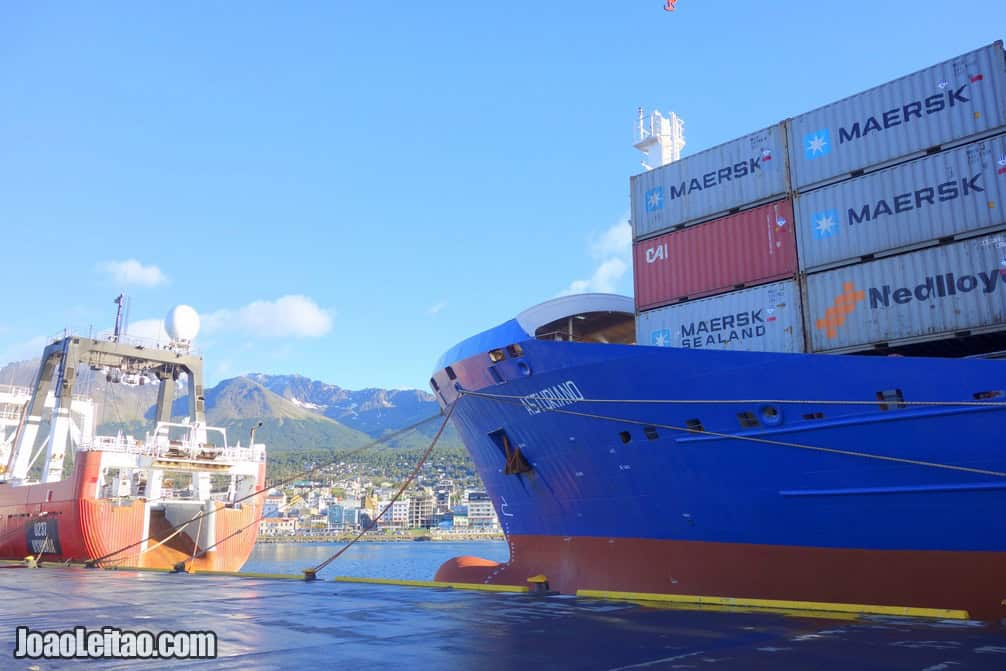
It’s a promising experience. It’s not the same as spending some days aboard a luxury passenger ship, with a pool and all-included restaurants. There are no recreational activities or movie theaters. You’ll face weeks aboard a cargo ship. The harsh reality of sea life. You’ll be a passenger among workers. You’ll cross the ocean without getting on a plane.
Regardless if it’s an oil tanker, a container ship, or a bulk carrier, life on board is simple. You wake up, wait for another day to go by, eat, and sleep. At least as a passenger because for the crew there are work shifts and the regular tasks that keep the ship running.
Few people know that many of these ships have some cabins and beds for passengers. Not too many, because according to the rules, if you carry more than 12 passengers you have to have a doctor on board and most companies don’t want that.
So, feeling isolated from the world is one of the problems to face. You may even be the only passenger aboard. Of course, you can bond with the crew members but that might not happen, and they’ll be busy with their tasks anyway, while you only have to kill time for one more day.
Watching how a ship works could be interesting, but after a few days, it becomes routine. Passengers are usually allowed on the bridge, but it becomes boring after a while.
Bring books to entertain yourself, movies, work, anything that helps to fill in the long hours of doing nothing.
Meals are served at the officers’ mess hall. The passenger eats with the crew, that generally speaks English, so you won’t have to worry about food.
But there are other issues: you’ll probably won’t have access to the Internet when traveling — a terrible deprivation for most people. And then there’s the cost: this is not the shipping companies’ core business, including passengers is an exception, and you’ll pay the price for that. On average, account for 100 Eur a day for this kind of trip. It may not seem like a lot, considering it includes food and accommodation, but calculate at least ten days to cross the Atlantic. And the Pacific Ocean isn’t smaller.
Some practical tips: check with your insurance company if your travel insurance policy covers incidents on this kind of ship. If your boat has a few stops along the way, make sure you find out if you need a visa to go onshore and if it’s worth the hassle.
Getting a Ride on a Recreational Ship
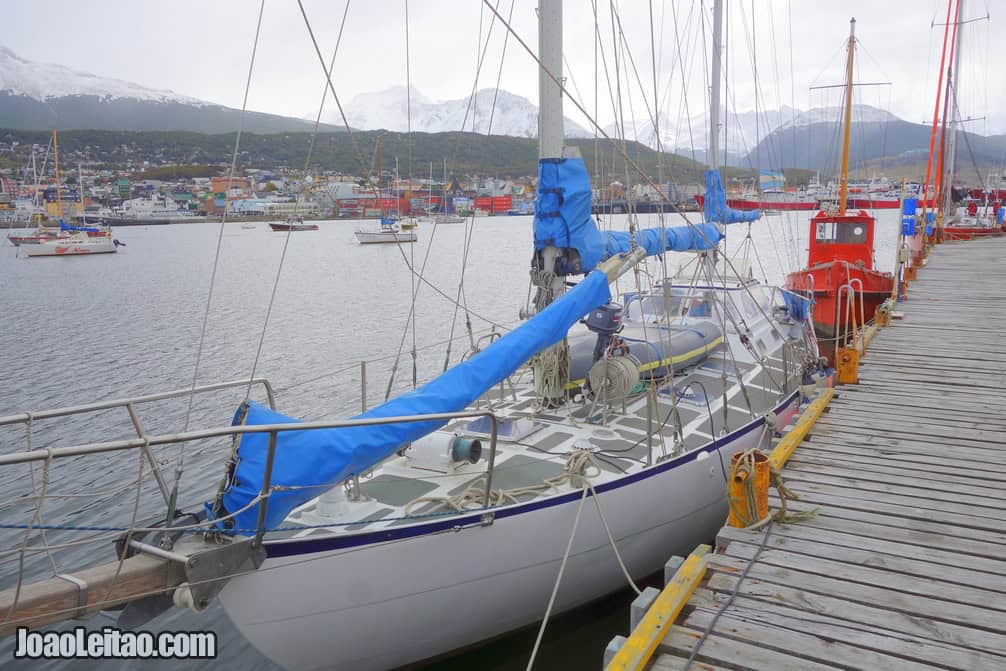
This is another resource that most people don’t know about or assume you need lots of experience, which is not entirely true. Of course, knowing something about seamanship and sailing might help you getting selected, but as long as you’re willing to help out with the tasks aboard, there’s always a chance of being accepted as a guest passenger on a sailboat or a recreational ship crossing the oceans.
It’s simple. The captain needs crew members and crew members need to cross the Atlantic. Crew members can travel for free in exchange for work.
You will still need some money. You’ll need to cover expenses with food, which generally means 10 to 25 Eur a day. In some situations, food is included in the trip, especially in bigger ships.
You can find the ideal situation for you in two ways:
- The first one is to go to a good-quality marina (like Great, in France, or Gibraltar, or Malaga) and strike a conversation with whoever is around. You might meet people in the same situation as you, exchange information with them, learn from those with more experience;
- The second one is to research online. Several websites (1, 2, 3, 4, 5) post ads for situations like these.
Keep in mind we’re talking about sailboats, so the wind plays a vital role in the whole operation. Departures from Europe to the Americas usually happen between September and February, most likely in October and November.
Most available opportunities are to cross the Atlantic. A lot of people crosses this ocean with obvious departure and arrival points. It’s more complicated when it comes to the Pacific Ocean. It’s six times bigger and full of islands. It will be tough to find a sailboat that will take you across this ocean. Account for stops in Polynesia and remember that the most obvious departure points are usually in Australia and New Zealand. As for the best times of the year, there’s a good stream of sailboats from Mexico to French Polynesia around March, with departures until July. On the opposite, the typhoon season, when no one wants to be at sea, starts in November.
Cruise Ships on Replacement Trips
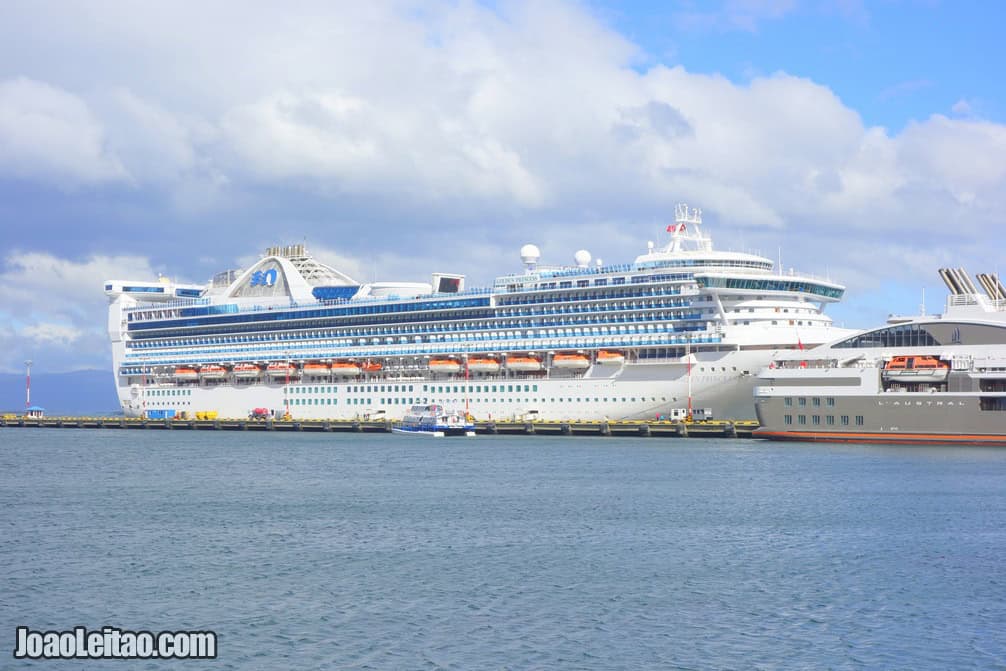
The luxury cruise ships crossing the seas with more or less wealthy tourists are sometimes transferred from one area of operations to another one, mainly to keep up with some regions’ seasonality.
The cruise ship type of traveler expects ships in a circular route meaning they depart and arrive in the same port or, at least, in the same region. But when the ship is being transferred to a faraway zone, it’s not as easy to find customers. That is when things become interesting.
Let’s say there’s a ship that after doing cruises through the fjords in Norway will be transferred to the Caribbean. It’s an excellent opportunity to cross the Atlantic, with all the amenities and usually at a lower price than cargo ships.
- How does 13 nights aboard a cruise ship from Barcelona to Florida for 620 Eur sound? To find more trips like this one visit Cruise Sheet.
Trip Around the World Exclusively by Ship
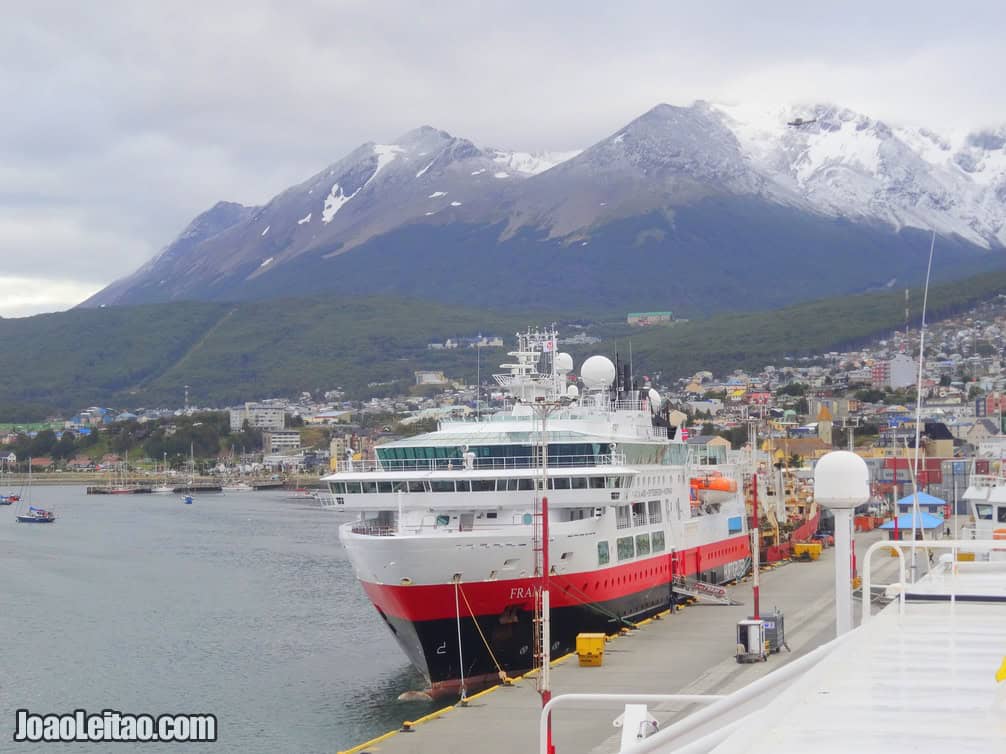
It’s possible to travel around the world exclusively by ship, but it’s meant for people with a particular taste and a lot of pocket money.
You can travel on a CMA CGM ship. It departs from the USA, and you can choose to travel around the world from west to east or the opposite direction. Going west, the trip lasts for 50 days, departing Seattle and stopping at the following ports: Vancouver (Canada), Yokohama (Japan), Shanghai, Ningbo, Hong Kong, and Yantian (all in China), Tanjung Pelepas (Malaysia). Then you go through the Suez Canal, sail across the Mediterranean, crossing the Atlantic, and reach New York. The trip costs 4,000 Eur, or 80 Eur a day.
The route is more or less the same in the opposite direction but has fewer stops. The duration and price are the same.
The traveling conditions are practically the same I described on the Traveling on Cargo Ships section.
- Visit Jupiter Travel to book your trip.
Round The World Online Resources
- Shanon decided to drop everything to travel around the world. She has an inspiring blog with useful tips for anyone who’d like to follow her steps.
- Wikihow has some very complete tutorials and has one for people who want to travel around the world.
- Alex McCaw traveled around the world for a year and wrote an article that could inspire those with a similar plan.
- On the blog Nerd Fitness, there’s a fabulous article that shows how it was possible to travel around the world for ten months with just US $418. It’s not for everyone!
- Although it’s a bit obsolete and too simple in some ways, the website Perpetual Travel is one of the most complete resources in helping people who’d like to travel around the world.


